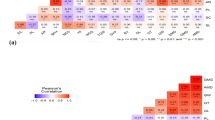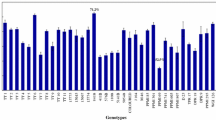Abstract
A study was conducted to evaluate the genetic divergence for morphological and phenological traits under rainfed conditions in wheat. Seed material comprised of the 294 wheat genotypes used for this study and grouped into six clusters. Among the six clusters, cluster IV contained 86 and cluster I had 68 genotypes, followed by 12 genotypes in cluster V. Fifty one genotypes were grouped in cluster VI and 52 were included in cluster II, while cluster III was represented by 27 genotypes. Maximum cluster mean for the character grain yield per plot was observed for the cluster III (667.1) followed by cluster V (559.3). The minimum cluster mean under the rainfed conditions was observed for the cluster IV (269.3). Intra cluster distance was maximum for cluster III (3.125). The highest inter cluster distance was noted between cluster II and cluster IV (4.997). Parentage of 294 genotypes revealed that genotypes belonging to different eco-geographical areas were included in the same cluster. This indicated that there was no association between clustering pattern and eco-geographical distribution of genotypes.
Similar content being viewed by others
References
Ali, M. A., & Awan, S. I. (2009). Inheritance pattern of seed and lint traits in Gossypium hirsutum L. International Journal of Agriculture and Biology, 11, 44–48.
Arnon, D. (1949). Measuring chlorophyll and anthocyanin concentration. Plant Physiology, 24, 1–15.
Barbosa-Nato, J. F., Sorrells, M. E., & Ciser, G. (1996). Prediction of heterosis in wheat using coefficient of parentage and RFLP-based estimates of genetic relationship. Genome, 39, 1142–1149.
Barrett, B. A., & Kidwell, K. K. (1998). AFLP-based genetic diversity assessment among wheat cultivars from Pacific Northwest. Crop Science, 38, 1261–1271.
Ehdaei, B., & Waines, J. G. (1989). Genetic variation, heritability and path analysis in landraces of bread wheat from South-western Iran. Euphytica, 41, 183–190.
Falconer, D. S., & Mackay, T. F. C. (1996). Introduction to quantitative genetics. Harlow: Longman. (ISBN 0582243025, 9780582243026).
Hiscox, J. D., & Israelstam, G. F. (1979). A method for extraction of chlorophyll from leaf tissues without maceration. Canadian Journal of Botany, 57, 1332–1334.
Hosseini, S. J., Sarvestani, Z. T., Pirdashti, H., Afkhami, A., & Hazrati, S. (2012). Estimation of heritability and genetic advance for screening some rice genotypes at salt stress conditions. International Journal of Agronomy and Plant Production, 3(11), 475–482.
Jagadev, P. N. (1993). Divergence in wheat under barani condition. The Madras Agricultural Journal, 80(8), 457–460.
Jatasra, D. S., & Paroda, R. S. (1983). Genetic divergence in wheat under different environmental conditions. Cereal Research Communications, 6, 307–318.
Mahalanobis, P. C. (1936). On the generalized distance in statistics. Proceedings of the National Academy of Sciences, India, 2, 49–55.
Manjarrez-Sandoral, P., Carter, T. E., Webb, D. M., & Burton, J. W. (1997). RFLP genetic similarity estimates and coefficient of parentage as genetic variance predictors for soybean yield. Crop Science, 37, 698–703.
Mohammadi, R., Armion, M., Kahrizi, D., & Amri, A. (2010). Efficiency of screening techniques for evaluating durum wheat genotypes under mild drought conditions. International Journal of Plant Production, 4(1), 11–24.
MSTAT C. (1989). MSTAT-C Software, Version 1.4. Crop and soil science department, East Lancing, MI: Michigan State University.
Mullan, D. J., & Reynolds, M. P. (2010). Quantifying genetic effects of ground cover on soil water evaporation using digital imaging. Functional Plant Biology, 37, 703–712.
Muller, J. (1991). Determining leaf surface area by mean of linear measurements in wheat and triticale. Archiv Fuchtungsfrschung, 21(2), 121–123.
Rao, C. R. (1952). Advanced statistical methods in Biometric Research. New York: Wiley.
Sharma, R. K. (2008). Genetic divergence among some differentially heat tolerant genotypes of wheat. Agricultural Science Digest, Karnal, 28(1), 69–70.
Sharma, B. D., & Hore, D. K. (1997). Yield attributes of rice (Oryza sativa) under acid, low phosphorus and high iron soil of Northeast region of India. Indian Journal of Agricultural Sciences, 67(12), 580–582.
Author information
Authors and Affiliations
Corresponding author
Rights and permissions
About this article
Cite this article
Bellundagi, A., Singh, G.P., Singh, A.M. et al. Genetic diversity for moisture deficit stress adaptive traits in bread wheat (Triticum aestivum L.). Ind J Plant Physiol. 18, 131–135 (2013). https://doi.org/10.1007/s40502-013-0019-x
Received:
Accepted:
Published:
Issue Date:
DOI: https://doi.org/10.1007/s40502-013-0019-x




